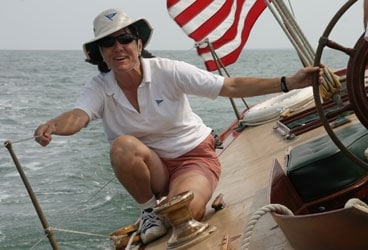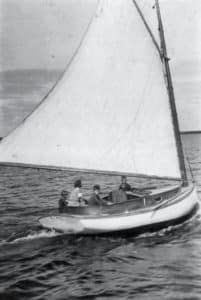
HWGleam368
I can’t remember the exact date that I last sailed aboard the classic 12-Meter Gleam, though I retain a firm grasp of the salient details, even though it was probably a good fifteen years ago, at least. I was trimming mainsheet; there were a bunch of New Yorkers aboard; we were contesting a charity event against a parcel of other Twelves, including Weatherly and American Eagle; Captain Bob Tiedemann ran a tight but congenial ship; and when all was said and done, all attention turned to the brimming cooler of ice-cold Budweiser. Good times.
Most of it came back to me with surprising clarity the other day when I stepped aboard Gleam for a practice sail just prior to the mid-August running of the annual Opera House Cup, one of a series of wooden-boat regattas sponsored by the fine Italian watchmaker, Panerai. The event was first run in 1972, and not surprisingly, considering that there’s about one degree of separation in the world of sailing, the inaugural edition was won by the Alden-designed yawl Mariner, skippered by none other than the same Robert Tiedemann.
Sadly, Captain Bob’s smiling, mustachioed visage (and his penchant for chilled lager) is no longer with us; he succumbed to pancreatic cancer, at 56, two years ago. But his wife, Elizabeth, has carried on the family business– along with Gleam, she charters out another Twelve, Northern Light, along with Mariner and several motor launches– for classic yacht regattas, corporate team-building exercises, weddings, and other affairs. When I was offered a ride for the practice session, I didn’t require a second asking.
Gleam was being chartered for the Opera House, and for the Vintage Class of the Nantucket 12-Meter Regatta that directly preceded it, by a syndicate that included Helen Baldwin, who was chartering the boat, built in 1937, for the second consecutive year. Baldwin and her mates were in high spirits after winning their class in the 12-Meter event in resounding fashion. “There’s something about sailing Gleam, out here on Nantucket, that’s very special,” she said.
The 12-Meters, of course, were the weapon of choice in America’s Cup racing for nearly twenty years, from 1958 until 1987. Though their days of Cup competition are gone forever, the class has enjoyed a resurgence in recent times, and next year the 12-Meter World Championships will be staged in Newport, R.I. They race in four distinct classes: the Vintage Class, for boats designed and built prior to World War II; the Classic Class, for full-keeled boats like Weatherly and Easterner, built after 1958 when the Cup resumed after a lengthy hiatus; the Modern Class, for Twelves with detached keels and rudders, beginning with Intrepid in 1967; and the Grand Prix Class, for the most recent additions to the fleet.
Tiedemann brought Gleam to Newport in the mid-1970s and the seaside city is now home to a veritable armada of 12-Meters that grace the waters of Narragansett Bay. Many miss him, but his legacy survives in the most tangible of ways: under clouds of canvas on each and every summer afternoon.
Today Gleam is skippered by a Brown graduate named Ben Blakely (and ably assisted by crew Lincoln Prentiss and Becky Chace); like most of the captains in Elizabeth Tiedemann’s tightly knit team, he served his apprenticeship as a deckhand under Captain Bob. Blakely was in Switzerland when Tiedemann became ill, and he never had the opportunity to compare notes with his old boss before he passed away.
“We never really had a chance to communicate,” said Blakely. “I just figure Bob had a grand plan in his mind for what he wanted to happen with Gleam and the other boats, so we’re trying to figure that out and carry it forward.”
There was a moderate breeze blowing as Blakely and crew hoisted Gleam’s mainsail and powered out of Nantucket Harbor. Then came the always magical moment when the auxiliary was shut down, the genoa was set, and the lean, powerful 68-footer leaned into the slight chop and slid effortlessly to weather.
We threw in a couple of tacks and then Blakely asked if anyone was up for setting the spinnaker (“Don’t tell Elizabeth!”), a notion that was met with unanimous approval. The kite went up without a hitch and it looked good; I asked Blakely where it came from and he laughed.
“Well, this particular chute was bought for the boat by a fellow who chartered her and bought a whole new set of sails,” he said. “But Bob was something of a packrat. We’ve got a barn full of stuff that’s vaguely nautical: binnacles, blocks, winches, pumps, some pretty useful stuff. Plus there are all these spinnakers. Bob used to get the old ones when someone in the Modern Class replaced their inventory. We’re still ‘recycling’ them.”
The chute came down and we hardened back onto the breeze, and everyone got a trick at the wheel. There’s something genteel, sophisticated, and very civilized about steering a classic yacht, particularly one as well-loved and looked after as Gleam. You hunch down to leeward so you can see the telltales; you’re ever so close to the water whooshing past; you wish every sailor could have at least a few minutes doing the exact same thing.
Too soon, it was time to wrap up the proceedings, douse the sails, and return to Gleam’s slip to prepare for the next day’s racing. On the way in, Blakely talked a bit about the projects of the last couple of years, and how much work it took to keep a museum piece like his classic command in fine form and fettle. Almost as an afterthought, he said, “I may move on at some point, but when I go, I’ll leave a piece of me on this boat.”
Somewhere, Captain Bob Tiedemann should know, his pride and joy is being cared far in a manner he’d very much approve.









